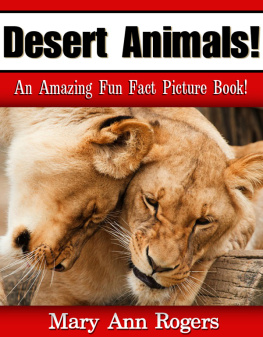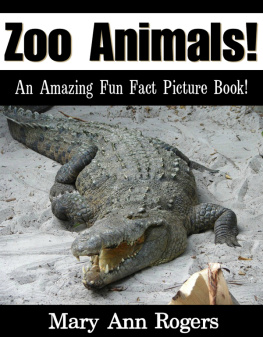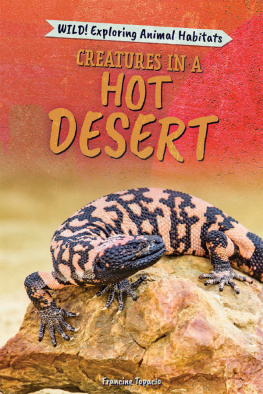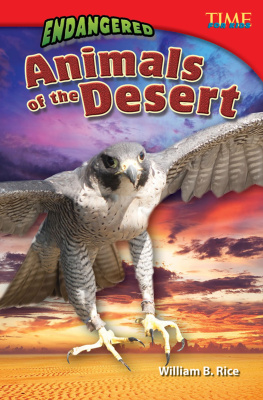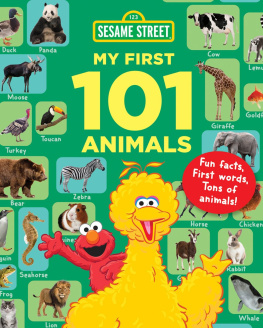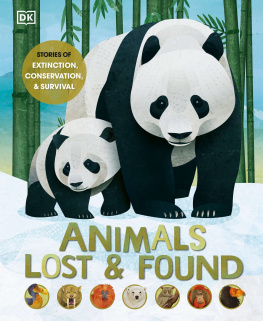Desert Animals
AnAmazing Fun Fact
PictureBook!
MaryAnn Rogers
Table of Contents
Publishers Notes
Copyright 2013 by Mary Ann Rogers. All rights reserved. Noduplication without the express written permission of the author.
TheDesert

The Desert
Thereare places on earth where the landscape is dry and hot, and where there islittle rainfall to support plant growth. Deserts cover about one third of theearths surface. Temperatures in very hot areas average around 115 F in thedaytime in summer months. Due to little humidity in the air, temperatures dropsignificantly at night, and can reach as low as the freezing level of only 32F at night in the winter months. Amazingly, there are animals that can surviveand thrive in such conditions. Lets take a look at some of them.
Elephant

Elephant Family
There are 3species of elephants that live in Asia, and both the dry and forested parts of Africa.Elephants have a unique anatomy. They have very large ears that are used to fanand help keep their bodies cool in the heat. They also have long snouts ortrunks that they use to communicate with other elephants, as well as to pick upfood and water. Elephants are highly intelligent, being compared to primates(monkeys), and travel in family packs, with the eldest female being the leaderor "matriarch." An adult male elephant is called a bull, anda female is called a cow.
Camel

DromedaryCamels
There are two types ofcamels that are characterized by the humps on their backs. The Dromedary camelhas one hump, while the Bactrian camel has two humps. Contrary to popularbelief, their humps do not actually store water, but are deposits of fatty tissue.However, their bodies have special characteristics which allow them to storewater in many different ways. Camels can therefore travel long distances inscorching temperatures without needing a drink.An average camel can drink around 50 gallons of water in under 4minutes!
Gazelle

Gazelle
The gazelle is a species of small antelope that livethroughout Africa and Asia. They are generally characterized as having whiteunderbellies and ringed horns. They are extremely fast runners, with bursts ofspeed of up to 60 mph, which can help them escape predators such as the cheetahor lion. Gazelles typically live and travel in herds. Their diet is mainlyplants and leaves and thus they are herbivores. Because of poaching and otherthreats, some species are considered endangered. You can tell if a gazelle ismale or female by their horns. Thefemales horns are shorter than the males.
Giraffe

Giraffe
Thegiraffe is the tallest mammal on planet earth, reaching an average height of 18 20 feet. The average male weighs around 3,500 pounds, with the femalestypically weighing half that amount. They spend most of their lives hunting forfood, with their main source being acacia leaves. They use their tongue, whichcan be as long as 21 inches, to pick the leaves from any treetops they canfind. Giraffes have many predators, including wild dogs, hyenas and lions. Thename Giraffe was derived from the Arabic word zarafa, which means fast walker.
Hippopotamus

Hippopotamus
Hippopotamuses aresemi-aquatic animals, spending most of their time in mangrove swamps and lakesto keep cool. At night, they emerge to find food, with grass being their mainfood source. Hippos, as they are commonly called, can consume up to 150 poundsof grass in a single night. They are the third largest land animal behind theelephant and white rhinoceros, and can weigh up to 6,000 pounds! Hippos aretypically aggressive and despite their large frame, can run up to 30 mph.Hippos have an interesting relative; t hey are the common ancestorof whales!
Lion

Lions
Lions are social animalsthat live in packs called prides, which consist of several females, their cubsand a few males. They are the second largest big cat species, with the tigerbeing the largest. Male lions have bushy manes that they use to make them looklarger and more threatening to competing lions. Females are the main hunters,hunting in packs and typically at night. Lions have been known to hunt humans,but occurrences are uncommon. The big cats spend most of their day (up to 20hours), resting. Lions will sometimes mate with other animals to createhybrids. A liger is a cross between a lion and tiger and occurs when a malelion breeds with a female tiger.
Coyote

Coyote
Coyotes live in many partsof the world, including desert climates. They are smaller carnivores that huntmice, prairie dogs, squirrels, and many other animals. Coyotes arecharacterized by the howls and barks they make, usually at dusk, that are usedto communicate with other coyotes. Coyotes use burrows to sleep, and whenhaving their young. Rather than dig these burrows themselves, they will oftenuse one a groundhog or badger has already made. A coyotes sense of hearing andintuition can help them detect a predator up to a mile away!
Rattlesnake

BasiliskRattlesnake
Thereare 32 species of rattlesnakes, which are widespread throughout the Americasand Mexico. These snakes are characterized by the rattle at the end of theirbodies, which shakes when the animal is being threatened. Rattlesnakes hunt smalldesert animals using heat-sensing pits on the sides of their heads. They thenuse their fangs to inject deadly venom into their victims. Rattlesnakesgenerally avoid humans and rarely bite unless they feel threatened. Bites areharmful to humans, but rarely fatal if antivenin is given promptly. Rattlesnakesdo not have a sense of hearing, and thus must rely on their other senses tohelp them hunt for food.
Rhinoceros

Rhinoceros and Baby
There are 5 distinct speciesof rhinoceros, whose name means nose horn." Two species, the white andblack rhinos are indigenous to Africa, while the Indian, Javan and Sumatranrhinos dwell in Asia. Their horns are made of keratin, the same protein that isin our fingernails. The white rhino is considered the second largest landmammal, and can weigh more than 7,500 pounds! Rhinos are herbivores, anddespite their large size, are typically gentle creatures. The only predators ofadult rhinos are humans, who hunt them for their horns. Agroup of rhinos is called a crash!

